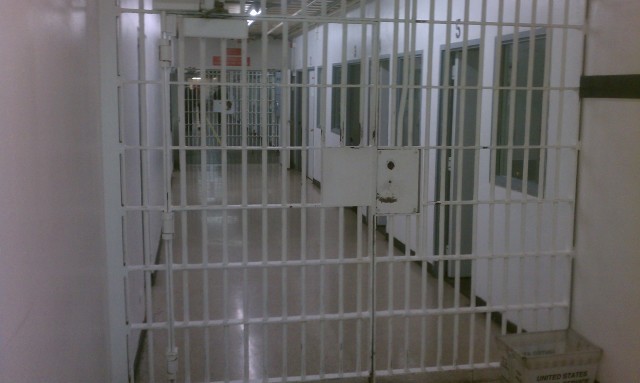$240 million project that nobody has seen and that might be obsolete the day it opens gets preliminary approval from board members who say they don’t like it. Go figure

By Tim Redmond
JULY 21, 2015 – The San Francisco supervisors today moved forward a proposal for a new $240 million county jail – although it’s not clear yet what the project will actually look like or whether the city needs it.
The convoluted issue stems from the fact that the state is offering up to $80 million in grant funding to replace the ancient, outmoded, unsafe, and inhumane lockup at 850 Bryant – but the clock is ticking and the money may be gone if the city doesn’t act soon.
So the supes had to vote today to approve an environmental review document that said the project needs no further review – unusual for a building this large – and at the same time vote to authorize the city to apply for the grant money.
The debate was at times bizarre – as Sup. Jane Kim put it, “I’m not sure we even have a project before us.” But on a 7-3 vote, move forward they did.
It’s not a simple issue: I’ve been to the County Jail in the Hall of Justice, and it’s just awful. The prisoners can’t stay there anyway; the place isn’t seismically safe and has to be torn down.
But the jail population is dropping, SF is getting better at alternatives to incarceration … and foes of the jail say it might be possible to handle the projected number of inmates without building some 350 more beds.
Help us save local journalism!
Every tax-deductible donation helps us grow to cover the issues that mean the most to our community. Become a 48 Hills Hero and support the only daily progressive news source in the Bay Area.
The sheriff, Ross Mirkarimi, who initially supported the new jail, now says that if the city put more money into mental-health treatment facilities, we wouldn’t need to build more cells.
Mayor Ed Lee is adamant about pushing this project.
There were two essential items before the board. First the supes had to approve the Planning Department’s “negative declaration” – a statement that a multistory edifice could not possible have an impact on the environment.
That’s a stretch, since nobody has actually seen architectural renderings or project plans. Even a spokesman for the Department of Public Works noted, “we do not have a formal project to present.”
So how can the board say it doesn’t need an environmental impact report? Kim was dubious: “How did Planning make an evaluation [under the California Environmental Quality Act] if the project is still in flux? …. It’s unprecedented and premature.”
But planners said they had enough of an idea to say it needs no EIR.
That got mixed up with the bigger question: Does the city even need a new jail? Many of the people who testified against approving the environmental review were actually arguing that San Francisco shouldn’t be in the business of finding ways to lock more people up, when it’s clear that the mass-incarceration model of criminal justice has been largely a failure.
The majority of the people now in county custody have been convicted of nothing – they are simply awaiting trial and can’t afford bail.
Again, the numbers are complicated. San Francisco actually has several jails: JC1, at the 850 Bryant Hall of Justice, is just an intake and release facility with holding cells but no beds. CJ 2, also at the Hall, is a relatively new facility with modern equipment, and is the only place where women are held; it can handle 464 inmates.
CJ 3, which could handle 426 inmates, and CJ 4, which houses up to 402, are very old-fashioned lockups with prisoners in barred cells in a long row. Visiting facilities are awful, there is limited room for classes, and nobody should ever have to live there. CJ3 is now closed.
CJ 5 is the new San Bruno facility, with room for 768 inmates. It’s modern, offers classrooms and recreation, and is one of the more chill (and progressive) jails you’ll ever see.
CJ 6, an empty concrete hulk in San Bruno, could be rehabbed for $80 million and could house another 250 people.
The current jail population is about 1,250.
So when you do the math, as Sup. Scott Wiener did, here’s what you get: We could demolish CJ3 and CJ 4 and not replace them, and we’d have room for about 1,300 inmates, roughly the current population. If we fixed up CJ 6, we’d be close to 1,500.
The Sheriff’s Office, however, says we need to be at no more than 85 percent capacity to have the flexibility to keep certain inmates apart (you don’t put competing gang members in the same cell). And the inmates at CJ4 are maximum-security prisoners who need special facilities. So Wiener argued that we need the new space just to keep up.
“The political thing to do is not to build a new jail,” he said. “There is no constituency that wants a new jail. But if we don’t do this we could wind up with overcrowding, or we could be forced to release people we don’t want to release.”
On the other hand, the trends are pretty clear: The population of the SF jail is falling. It might well be that in three or four years, when this project is shovel-ready, we won’t need that many beds.
And, as Mirkarimi says, we might come to our senses and start treating mental illness as a public health issue and not a criminal issue.
At any rate, the city is pretty close to where it might be creating unnecessary jail cells – and $240 million for a new jail that might be obsolete the day it opens is a big gamble with a lot of money.
And there’s a sense of the money pressure here: City officials repeatedly said that if the supes didn’t approve the CEQA review, and didn’t give their blessing to the preliminary project, the $80 million state grant would be in jeopardy.
Of course, the supes were told, this is just the beginning, and the project can be altered or even scrapped later. I have heard this many times before – and preliminary approvals tend to turn into final approvals. Can you see the board turning down $80 million (some of which might have already been spent) a few years from now?
Even the people who voted in favor of approving the environmental review and proceeding with the grant application agreed the project isn’t good. “I don’t like this plan, it’s too big and too expensive,” Sup. London Breed said. “There are not enough mental-health resources. I feel like this process is death by 1,000 cuts. And if we get the grant, we’ll be told we can’t stop it because we’ll lose $80 million.”
And yet, she voted to go ahead. So did everyone except Kim and Sups. Eric Mar and John Avalos (Sup. David Campos was out of town).
So now this project moves to the next level. I wonder at what point it becomes unstoppable.




